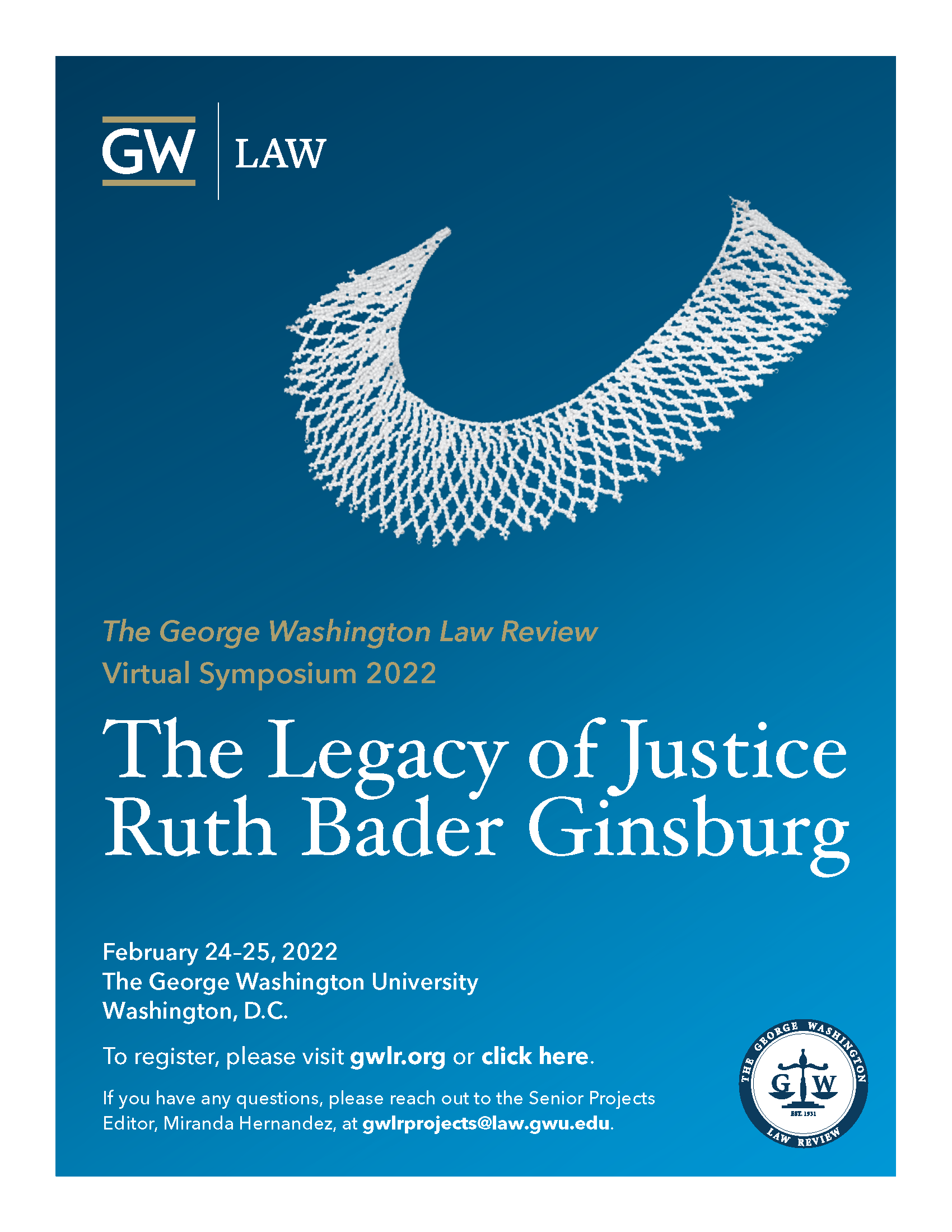Volume 90 Symposium
Justice Ruth Bader Ginsburg was, by any estimation, one of the towering legal figures of the 20th and early 21st century. Justice Ginsburg’s life and work as a scholar, advocate, judge, and justice meaningfully changed the law, and her iconic presence and personal life path inspired generations of lawyers and activists around the world. Best known for her path-marking work on issues of gender equality, Ginsburg also made significant contributions to jurisprudence in Civil Procedure, Conflict of Laws, Administrative Law, International Law, and many other fields.
The George Washington Law Review was pleased and honored to host the first comprehensive legal academic consideration of Justice Ginsburg since her death in 2020. A group of leading legal scholars and sitting judges, all of whom clerked for Justice Ginsburg, provided analyses of various aspects of Ginsburg’s scholarship and jurisprudence, as well as personal reflections on her ongoing influence on the lives of those she hired as clerks. Justice Stephen G. Breyer offered keynote remarks and answered questions about Justice Ginsburg as a colleague and friend.
Interestingly, the authors chose not to focus so much on Ginsburg’s obvious contributions to the Supreme Court’s jurisprudence on gender equality, perhaps because those contributions have already been covered exhaustively in the scholarly literature. Instead, the articles here homed in on more subtle aspects of Ginsburg’s jurisprudential legacy: her abiding interest in procedure, the importance of humility in her decision-making, and her contextualist, non-formalist, approach to statutes, federalism, separation of powers, lower court decisions, and precedent itself. Together, the essays and remarks collected in this symposium issue provide a taste of Justice Ginsburg’s extraordinary body of work and a thoughtful consideration of her judicial approach.
Click here for the full Symposium Program.
Panel Reviews
Thursday, February 24, 2022
Judicial Panel
[click here to read summary]
- Bradford R. Clark (moderator), William Cranch Research Professor of Law, The George Washington University Law School
- The Honorable Goodwin H. Liu, Associate Justice, Supreme Court of California
- The Honorable John B. Owens, Judge, U.S. Court of Appeals for the Ninth Circuit
- The Honorable Paul Watford, Judge, U.S. Court of Appeals for the Ninth Circuit
Friday, February 25, 2022
First Panel
[click here to read summary]
- Maeva Marcus (moderator), Research Professor of Law and Director, Institute for Constitutional Studies, The George Washington University Law School
- Rachel Bayefsky, Associate Professor of Law, University of Virginia School of Law
- Paul Schiff Berman, Walter S. Cox Professor of Law, The George Washington University Law School
- Daphna Renan, Peter B. Munroe and Mary J. Munroe Professor of Law, Harvard Law School
Second Panel
[click here to read summary]
- Laura A. Dickinson (moderator), Oswald Symister Colclough Research Professor of Law, The George Washington University Law School
- Abbe R. Gluck, Alfred M. Rankin Professor of Law and Founding Faculty Director, Solomon Center for Health Law and Policy, Yale Law School
- Aziz Z. Huq, Frank and Bernice J. Greenberg Professor of Law, University of Chicago Law School
- Anne Joseph O’Connell, Adelbert H. Sweet Professor of Law, Stanford Law School
- Amanda Tyler, Shannon C. Turner Professor of Law, University of California, Berkeley, School of Law

